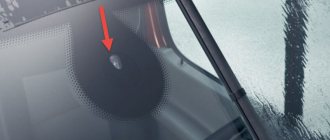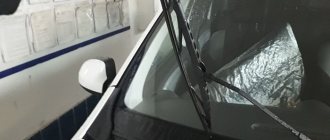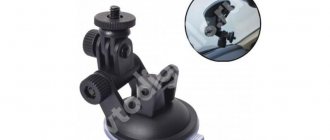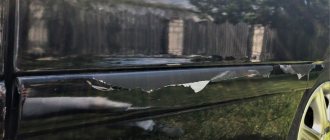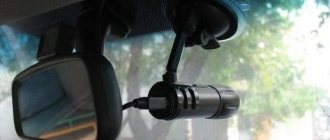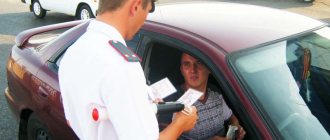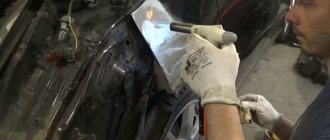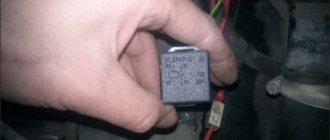Demand for color
Designers advise painting the dashboard in the same color as the interior, choosing a slightly lighter shade. This reduces the strain on the driver's eyes. To make the interior of the cabin original, you can use one of the current colors: anthracite (charcoal color with a dusty effect) or titanium (golden hue with matte or dazzling glossy effects).
Repairing a car dashboard using “liquid rubber” paint is popular. When dry, this composition forms a smooth, rich matte surface, pleasant to the touch and resistant to negative influences.
If you are planning to change the interior design of your car, then you cannot do without reupholstering the front panel, or, as they call it in everyday life, the dashboard. You can choose a new color scheme and texture for it. Or you can use materials similar to the previous ones and only slightly refresh the scratched and worn-out coating. Many motorists do not risk re-tightening the panel with their own hands for fear of ruining the appearance of the interior. However, the biggest difficulty in this process is deciding to start work. In addition, if you already have experience in reupholstering other interior elements, this task will not cause you any difficulties either.
Difficulties of functional tuning
Often, functional tuning is limited only to replacing older or faulty car devices with newer and more modern ones. However, we should not forget that functional tuning also includes the installation of additional vehicle control elements such as an immobilizer, on-board computer or built-in additional devices. The main problem with such modification is not so much the choice of components as their proper installation. Most often, novice tuning enthusiasts who want to carry out such an installation at home will have to face such a problem as difficulties in calibrating devices. Imagine that the speedometer will show an inadequate speed of the car or the fuel gauge will deceive you at the most inopportune moment.
Separately, it is necessary to say about such a point as the legality of modifications. That is, if the design of the car provides for a speedometer or tachometer of the exact model that is installed at the factory, it will be quite difficult to explain its replacement during maintenance. Therefore, it is better to carry out aesthetic tuning of devices that have already been installed on the car, and place additional ones either on top of the dashboard or in those places that are still free. Aesthetic question
When carrying out aesthetic tuning, you need to carefully plan everything, because you will need no less skills than when carrying out a functional improvement of the dashboard, and in addition to it you will also need an excellent sense of taste. If you yourself know what you want, all that remains is to prepare the necessary materials and elements, and we’ll talk about this a little later, but if you don’t have a clear plan, then it’s worth developing it in advance.
First of all, look for inspiration on car forums or ask for advice from motorist friends who have tuned their cars. Naturally, each person has his own taste, but someone’s ready-made improvements may well lead you to an interesting solution that you can later implement. In addition, knowing what you want to achieve with your car, you can easily select the necessary materials and apply certain solutions related to the manufacture of elements necessary for tuning.
ClassicAutoClub.ru
02/01/2016 Topics: Dashboard / Vinyl film / DIY
The dashboard is one of the most important parts of a classic car's interior. Who enjoys looking at an untidy or flaking dashboard while driving?
We have previously talked about the restoration of plastic in the interior of a car using our second generation Toyota Celica as an example. And today we will talk about restoring the dashboard.
Many classic model dashboards are finished with vinyl wrap. This gives a soft, slightly grainy surface that is pleasant to the touch. At least that's how it was when the car came off the assembly line. Over the decades, the sun's rays and water leaks have pretty much damaged it, not to mention the holes where the previous owners screwed in eight-track tape recorders and other modern accessories for that time.
If the dashboard is simple - stamped steel with or without a soft backing in case of impact - you can restore it yourself. To replace the cover, all you need is glue, vinyl film, basic tools and a little care.
The necessary materials can be bought in a regular store, but it is better to purchase them from a specialist in finishing classic models - this will definitely ensure their suitability.
YOU WILL NEED:
Equipment: High temperature contact adhesive, vinyl wrap, closed cell polyurethane (optional), brush and/or spatula, sharp scissors, cutter, hair dryer or industrial blow dryer. Time: 15 hours Costs: from 5,000 to 12,000 rubles Difficulty level: 4
MATERIAL SELECTION
Surface finishing.
Not all vinyl wraps sold in stores look good on your dashboard. Consider how shiny or matte it is, its graininess, and how it feels. When applying, flexibility is also important.
We measure out the vinyl film.
Cut a piece of vinyl film with a large margin. Don't skimp, otherwise there may not be enough to cover the entire surface. You may have to cut along the roll rather than across it, so measure the piece you need before purchasing.
Type of vinyl film.
Some stretch vinyl films will come loose after some time as the plasticizers penetrate into the adhesive. Find a textile-backed vinyl film that stretches just right and ask your salesperson for advice.
Polyurethane layer.
Many dashboards have vinyl film that is bonded directly to the metal surface, which is exactly what we replicate. However, on some models a layer of polyurethane is laid over the metal for softness. In this case, replace it with 2-3mm thick closed cell polyurethane sheet (available from finishing specialists).
You will need high temperature contact adhesive which is applied with a brush or spatula. Avoid aerosols and regular contact adhesive (it can come off or bubble in the sun).
Surface inspection.
Small particles of dirt, scratches, potholes, and surface imperfections on the dashboard will be visible under a layer of new material, even quite thick. It is extremely important to thoroughly prepare the surface.
PREPARATORY WORK
Remove the dashboard.
It's usually easiest to remove the dashboard and pull it out. Label the wires with paper tags; disconnect the throttle and speedometer cables; separate the heater air ducts. Remove the instrument panel, keeping the screws and bolts (refer to the repair manual for their location).
Cleaning the panel.
Remove any hardware that is attached to the dashboard, then scrape off the old vinyl covering. The old glue needs to be removed - you can either simply scrape it off, or soften it with a solvent (for varnishes, for example) and wipe it off. It is advisable to degrease the surface of the dashboard.
Assess the damage.
Remove any rust using a rubber-backed sanding wheel. Hard sanding discs will leave a mark and it will be visible. Be careful with the sharp edges of sheet metal. Process them with a file or sandpaper.
SEALING HOLES
Clean the edges.
Often, after removing an unnecessary device (for example, an ammeter or ashtray installed by a former owner), there remains a hole that needs to be sealed. First, make sure that the rough edge of the hole does not protrude. Carefully remove any protruding areas using pliers or a file.
Patch.
Clean and degrease both sides of the dashboard. Now press a piece of steel (or other rigid material) to the back of the dashboard using fiberglass filler. Wrap the fiber around the back of the patch for strength.
Surface cleaning.
Use a spatula to smooth the top surface. Once dry, sand the surface with coarse sandpaper and a block until it is smooth and does not stand out. If dents remain, fill them with filler and sand them again with sandpaper.
COVERING SMALL AREAS
Keep the original coating.
Many dashboards have additional sections made of semi-solid polyurethane, such as a “shock pad”. To prevent the old polyurethane from falling apart, a new coating must be applied on top of the old one.
Wrap in polyurethane.
If the vinyl is cracked or curled, smooth it out using sandpaper or a sanding wheel on a drill. If the area you are working on requires a soft finish, it can be wrapped in flexible closed cell polyurethane.
Cleaning the profile with sandpaper.
An additional layer of polyurethane can still be applied using contact adhesive. Once the glue has completely cured, carefully use a block and coarse sandpaper to shape the edges as desired.
Apply glue.
Whether you use polyurethane or not, the method remains the same. Cover both surfaces with an even layer of glue. Make sure there are no gaps or clumps of glue that will not set properly. Set aside until dry. If the glue is thick, spread it out with a spatula.
Attach the vinyl film.
This usually takes about 15 minutes. Do not hurry. Carefully combine all materials. They should stick together tightly and instantly, and after compression, remain motionless.
Final finishing.
Finish the area by gluing the edges and then folding and cutting off the excess. The ends should be tucked in carefully if they are visible on the dashboard after finishing.
COATING THE INSTRUMENT PANEL
Do the work in parts.
On the main panel, it is best to glue the material in parts. We divided our work into covering the top surface, middle surface and vertical bottom surface. Start by centering the material on the panel.
Glue the first piece.
Apply glue to the first section of the panel and then attach the vinyl. Press the film from the center to the edges. You can place parchment paper under the vinyl layer and then pull it out when the vinyl is stretched and ready to be glued.
Glue the following sections.
Level the surface and ensure that the vinyl is stretched evenly, especially over openings such as the dashboard opening. Once the first piece is in place, apply adhesive to the next section of the dash and then attach the matching piece of vinyl. Press down on the vinyl with a soft cloth to ensure even pressure.
Small notches.
If there are small indentations stamped into the surface where the vinyl film should go, it is best to ignore them when applying the bulk of the film. Immediately after attaching the sheet of vinyl, press it into the grooves with a piece of soft cloth. In deep recesses, use a commercial hair dryer (or hair dryer) to soften the vinyl.
Pull the vinyl taut around the edges.
Do not glue the edges and sides until you have finished the main surface. Wrap the film around the edge and pull it tight to avoid wrinkles. In the corners, if necessary, make corner V-shaped cuts.
Wrap the edges.
If possible, wrap the material around the edge of the dashboard and glue it to the back. This will hide the jagged edges of the metal and prevent the vinyl from shrinking along the edges as it ages.
FINISHING THE JOB
Cut out the holes.
Cut holes (for switches, radios, etc.) strictly along the edges of the openings. Cut with a utility knife with a new blade or scalpel. Start by moving slightly inward from the edge of the opening, then move the blade toward the edge and slowly trace its outline.
Cutting small holes.
Poke a hole through the back with a needle to mark its position. Cut holes from the front to avoid causing the vinyl to bulge. The knife should move smoothly in one direction. If it moves back and forth like a saw, the edges will end up ragged.
Install appliances.
Reinstall the equipment on the dashboard. Treat faded plastic with a finishing revitalizer. Some components are best installed while the dashboard is in place in the vehicle (for example, electrical items with non-removable wiring). Take care to protect the surface of the dashboard while working!
You can do all this yourself, but if you can get a helper to hold the new material on the main part of the panel, there will be less risk of bubbles or wrinkles.
The techniques described here will not work for later instrument panels that use molded polyurethane in complex configurations around the raised area for instruments and other fixtures.
Text: Dmitry Britantsev
What the experts say
Professional car detailers have accumulated extensive experience in retouching car panels inside and out. Here's a short list of tips from the experts:
- Practice first. Take a small piece of fabric and sew the item back together.
- Prepare the surface thoroughly, as unevenness or grains of sand will certainly appear on the fabric (defects will not be scratched on dense fabrics).
- Take your time or you'll have to pack everything up and start over.
- Peel off the backing carefully to prevent the adhesive surface from sticking to itself.
- Do not hold the hot hair dryer too close to the substrate, otherwise the substrate may be easily burned.
A cracked or damaged torpedo is not a death sentence. It can be easily returned to a state that will please car owners and arouse the interest of passengers. All you need to do is choose the right material and spend some free time on it.
Selecting material for reupholstering the front panel of the machine
The torpedo is constantly in sight, which means its appearance and quality will be striking both to you and to other passengers. The selection of material for reupholstering the front panel should be approached responsibly. Most often, the following materials are used in the interior design of a car:
- leather (artificial and natural);
- Alcantara (another name is artificial suede);
- vinyl.
You should not select material via the Internet. Pictures and descriptions will not give you a complete picture of the product. Before making a purchase, stop by a specialized store and feel each of the materials offered. It is also worth writing down the manufacturer and name of the shade. After this, you can order goods from the online store with peace of mind.
Genuine Leather
Genuine leather is a good choice for upholstering the front panel. This is a durable material that is not afraid of temperature changes, getting wet and fire. In addition, its surface is resistant to mechanical damage. Of course, you shouldn’t deliberately scratch the skin with a nail, but white stripes won’t appear on it by themselves either. The leather can be easily cleaned of dirt by regularly wiping it with a damp cloth. You don’t have to worry about the panel fading in the sun—it’s not afraid of ultraviolet radiation. And there’s no point in talking about the appearance of genuine leather: it will fit perfectly into the interior of even the most expensive and pretentious car.
Genuine leather gives the car interior a sophisticated look
Eco leather
If you can’t afford genuine leather, use its modern substitute - eco-leather. This type of material is called environmental because it does not emit harmful substances during operation. It doesn't look at all like the cheap leatherette of the late 90s. This is a durable, moisture-resistant and vapor-proof material that can maintain its appearance for a long time. Do not be afraid that the eco-leather coating will crack in a short time. In terms of its performance qualities, the material is not inferior to genuine leather. In addition, eco-leather is suitable for drivers with allergies.
eco-leather has good performance characteristics, but is much cheaper than natural leather
Alcantara
Recently, Alcantara has become one of the most popular materials for interior upholstery, including the dashboard. This is a non-woven synthetic material that feels like suede. It combines a velvety soft surface with easy care and high wear resistance. Just like skin, it does not fade in the sun. High humidity and temperature changes also do not affect it negatively. Many drivers prefer to cover the entire interior with Alcantara to create an atmosphere of home comfort. Others use it to design individual elements to dilute the severity of the leather. In any case, Alcantara is perfect for covering a dashboard.
Alcantara is a synthetic fabric similar to suede
Vinyl
If you want to create an unusual interior design, consider using vinyl films. There is a rich variety of textures and colors on the market today. You can choose a calm black or gray color, or you can find an imitation python fabric in an acid green color. Chrome-plated films, as well as films with a carbon or metallic effect, are very popular. They are even easier to care for than leather. Vinyl films have, perhaps, only one drawback: they are easy to accidentally scratch. But the low price allows you to re-tighten the panel as often as you want.
Using vinyl film you can imitate various materials, including carbon fiber
In order to save money, some motorists do not purchase special automotive material, but a similar one intended for reupholstering furniture. At first glance, it seems that there is no difference between them. However, this is not true: furniture leather and other materials are designed for use at constant and comfortable indoor temperatures. The car heats up in the bright sun and cools down in the cold. Furniture materials will quickly crack under such conditions.
Where do the sounds come from?
The main reason for the occurrence of various noises that come from the dashboard is the lack of integrity (solidity) of the structure:
- Since a modern panel is completed (consists) of many plastic parts, which are fastened together using a variety of latches, clips, and screws
- Such fasteners weaken and break over time, and this leads to vibrations of the dashboard elements; when friction occurs, the elements begin to make rattles and squeaks
- The general background noise is amplified by the filling of the dashboard
- Poorly attached elements of the cabin heater, wiring harnesses, pads, electrics, and others, when the car is moving, especially on uneven sections of the road, begin to hit the dashboard lining, producing an unpleasant clanging and ringing sound.
- The noise level is also greatly influenced by the quality of the instrument panel cladding inside the car.
- Such problems can easily be fixed with your own hands, and without the help of specialists.
- You just need to first study our article, purchase the necessary materials, be patient and work carefully
- Anyone can silence the dashboard on their own.
- In addition, you can also turn the dashboard into additional noise protection, in other words, an “acoustic shield”
- What will allow you to protect the car interior from noise coming from the engine compartment and engine
Remedies
There are two ways to install sound insulation into the dashboard:
- The first is dismantling the entire dashboard, followed by complete disassembly and covering with sound insulation.
- The second is the dismantling of the panel cladding and its partial sound insulation
- Of course, a much greater effect from this procedure can be achieved by performing the first method
- However, this method, unfortunately, is not always possible.
- For example, in Russian car models and inexpensive foreign cars, the first method solves this problem
- But in imported luxury cars, which are stuffed with various electronics, as well as airbags and other sophisticated systems, you will not be able to implement the first method yourself
- Fortunately, there is usually no need to soundproof the dashboard of an expensive car.
Do-it-yourself car torpedo reupholstery
Reupholstering the front panel begins with its dismantling. This is a rather labor-intensive process. In addition, the pattern of fasteners and clamps is not the same on different car models. There are a large number of wires connected to the panel, and if you are afraid of damaging them, contact a car service center for help.
If you want to do this yourself, do not neglect the car’s operating instructions: all parts and fasteners are described in detail there. Removing a torpedo always begins with disconnecting the battery terminals. Once you have de-energized your car, you can begin dismantling.
Setting up the ESP-8266
Before connecting the ESP8266 Module to the circuit, it must be flashed and configured in Tcp2uart (tcp to uart) transparent bridge mode so that it transmits the received data from the com port to the tablet via Wi-Fi.
It is better to flash via a USB-UART converter, which must have a 3.3V source output to power the ESP8266. Also, this source must provide the required current of at least 200mA.
Ready! Now, when the ESP-8266 module is connected to the Arduino, it operates in transparent bridge mode and transmits the necessary data via Wi-Fi.
The cost of reupholstering the front panel of a car yourself
The amount you spend on reupholstering a torpedo directly depends on the cost of the material. The average price for high-quality natural perforated leather is about 3 thousand rubles per linear meter. A standard size panel will take no more than two meters.
Eco-leather is already much cheaper: it can be found for around 700 rubles, although there are more expensive options. The price of vinyl film ranges from 300–600 rubles, depending on the type and quality. As for Alcantara, its cost is comparable to genuine leather, so you won’t be able to save on artificial suede.
High-quality high-temperature glue will cost you 1.5 thousand rubles per jar. We do not recommend using cheap superglue or Moment glue: you will be bothered by an intrusive smell, and the coating itself will deteriorate if the car heats up too much. Threads for leather products are sold at a price of 400 rubles per spool. Let's assume that you already have a hair dryer and a sewing machine at home, which means there will be no additional expenses for equipment.
Thus, we receive from 1.5 to 7 thousand rubles for the material, plus 2 thousand for consumables. As you can see, even when choosing expensive leather, you can spend 10 thousand rubles. In the salon, the price tag for this procedure starts from 50 thousand rubles.
The process of re-upholstering a car dashboard with your own hands has many nuances. However, the difference in price between do-it-yourself work and the service of a car workshop is so great that you can spend time studying the instructions, and then on the reupholstery itself. In addition, it will not take much time: the panel can be dismantled in 1.5–2 hours. It will take the same amount of time to reupholster. And if you find an assistant, then things will go much faster.
Tools and consumables
To make your own car bumper, you will have to purchase the following:
- Polyurethane foam . Sold at any hardware or hardware store. To inflate a bumper of standard sizes, you will need no more than 5-6 cylinders of 750 milliliters each. If you want to start a masterpiece of garage tuning, then immediately take 1-2 more cylinders.
- Gun for working with polyurethane foam . There are different configurations. In this case, there is no point in spending much money - buy whatever is cheaper, or the first one that catches your eye.
- Masking tape . It is better to take one that is 4-5 centimeters wide. It’s not worth taking the cheapest one, as it doesn’t stick well and is difficult to come off later.
- Epoxy resin . Sold in the form of two gel-like liquids, which must be mixed immediately before use, observing the proportions indicated on the package or in the attached instructions. If you have a choice, it is better to take epoxy that is not transparent, but with some color (as an option, you can add a dark color). This frozen form will be better visible and therefore easier to process.
- Fiberglass . Usually sold in roll form. Dimensions do not play any role here, since in the process the canvas will need to be cut into small pieces.
- Culinary foil . You can try to steal it from your mother (or wife) in the kitchen, or you can buy it. She's cheap. You will need approximately two standard rolls.
- Stationery knife . It must be at least more or less high quality, since you will have to work with it a lot. Don't forget to buy a set of replacement blades, as they get dull very quickly.
- Sandpaper . You need to take a little bit of different grain sizes - from coarse to the very, very fine. Experienced specialists in this matter use an angle grinder with appropriate attachments or an orbital sander. One way or another, manual labor cannot be avoided anyway.
- Putty . Ordinary, automobile, which is used for body repairs. As a rule, it takes very little, so a small jar of 100-200 grams is enough.
- Painting machine . Primer, paint and varnish for finishing the part. If you don’t have a compressor with a spray gun, you can get by with aerosol cans. A total of two units of standard volume will be required.
Selection of materials
First, it would be useful to analyze the extent of damage to the interior in order to understand what exactly needs to be changed and what can be left as is. The second nuance is to take into account the quality of the interior finishing, because different materials require different tools for work.
A leather interior will require maximum effort and investment. Here the car owner cannot do without “liquid skin”. In addition, the procedures will be carried out several times.
Using a B-compound type hardener, the damage is filled. It is easy to make an impression of the leather interior design using a special gel, and then apply this film to the repaired area.
If we talk about fabric, the interiors are in most cases velor. Then you need velor. Patterns can be carefully removed elements of old casing or some part of it.
We select the interior texture using a repair kit of fibers with a different number of colors. The damaged areas are treated with a special glue, and then fibers are applied with a brush or spray to match the interior color. A special Teflon film is placed on top of the fiber, after which it is ironed.
A plasticizer gel is a good choice for repairing plastic parts (you can use a universal transparent B-gel). This gel is capable of reliably gluing plastic surfaces and makes the parts being repaired not very noticeable against the background of the factory ones.
Check out a couple of stores that specialize in selling a variety of automotive chemicals. There you can find a lot of interesting options for materials that will help you repair the car interior with your own hands more efficiently and not very difficult. The car market can offer cheaper options for materials, but, as they say, the miser pays twice - there would be no need to change the entire interior later.
Useful tips
We figured out how to reupholster a car interior with your own hands. Technology, video instructions and photographs are at your disposal. It remains only to clarify some points:
- You need to use high quality glue. A professional two-component shoe glue for working with leather is suitable. It dries very quickly, but has a specific smell. After drying, the smell will completely disappear;
- For sanding plastic parts, regular sandpaper is suitable;
- When heating the material, be careful. You can, after all, burn it through by accident;
- Carry out the markings carefully. It’s better to check the dimensions 3-4 times in a row than to cut and sew a “cover” that turns out to be much smaller/larger than needed;
- You need to sew the covering elements together with a dense, strong thread. Nylon, which is usually used by shoemakers, is ideal.
Repair or DIY restoration
The passive safety system in the form of airbags is activated in the event of a strong collision of the vehicle head-on or side with another object. Regardless of the driving speed, the activation of the SRS complex is also influenced by the angle of the collision, the severity of the collision object and the vehicle's surface. As a result, deployed airbags destroy the dashboard of the vehicle.
Based on the combination of the factors described above, it becomes clear that an accident can cause minimal damage, or it can have catastrophic consequences for your transport. Therefore, the choice of repair method - independent or professional - will depend on the total amount of damage.
It would be better to restore the dashboard of a heavily damaged vehicle in a car repair shop. Such a service, according to the most conservative estimates, will cost from 5 to 10 thousand rubles. depending on the region. The cost will be influenced by the quality of the selected materials and the amount of restoration work, and the final amount may exceed 25 thousand rubles.
If, as a result of a traffic accident, the inside of the car was not seriously damaged and functions quite stably, and you have enough manual skills and patience, then you can independently restore the torpedo after the airbags have deployed.
Method of using the device
In order to use the torpedo to install nets under the ice, you need to unscrew the back cover of the device. Then place large batteries into the opened cavity. After which you need to check that the device is ready for operation, which can be easily done by lightly pulling the rope:
After making sure that the torpedo is in working order, you can go out onto the ice. Directly on the spot, the fisherman cuts a hole into which the device will be lowered. Then a cord is tied to the twine, with the help of which the net will be stretched. The torpedo is lowered under the ice, into a hole, and directed in the desired direction. A slight tug on the rope sets it in motion. Due to the fact that the device rubs against the ice with its wheels, the fisherman hears this grinding sound and also sees a glowing light bulb.
Repair methods
There are three main approaches to repairing a dashboard after airbag deployment:
- Functional repair of instrument panels includes mechanical restoration. The dashboard and steering wheel are installed in place, and new airbags are mounted under them. After this, the program resets information about airbag deployment;
- A complete interior dashboard repair includes not only mechanical repairs, but also aesthetic ones. The console is dismantled, a complete reupholstery is carried out using selected materials, a new SRS complex is inserted under the steering wheel and covers and reprogramming is carried out. This method makes it possible not only to recreate the transport security system, but also to change its internal appearance;
- A rough repair is suitable for cases where the car has received minimal damage and does not require major restoration procedures. In this case, the holes where the pillows used to be are filled with polyurethane foam, and the covers are installed in their original place. This method is bad because in the event of a new accident, the SRS complex will not work, because there will be nothing to work. By resorting to the third type of repair, you endanger not only your life, but also the lives of your passengers.
Incredible ideas for transforming and improving the dashboard - tuning
To make their car stand out from the gray mass, many car owners do tuning. However, today tuning means not only improving the appearance of the car, but also improving the interior of its cabin. One of the options for improving the interior is tuning the dashboard. You can learn more about this procedure, as well as upgrade options, from the material provided.
In what cases can glass repairs not be carried out?
Before telling you about the process of windshield repair, it is worth saying in which cases the windshield is completely beyond repair. Of course, it is almost always possible to cope with this or that damage, but there is a certain point of the rules, on the basis of which the damaged windshield must be replaced with a new one, or with any other one that can be used in connection with this point of the rules.
So, repairing chips on the windshield and repairing it are, in principle, not possible if the diameter of the damage is more than 5 mm. In this case, you need to replace the windshield with a new one, since driving such a vehicle is prohibited by law. The second situation, in which you also need to replace the windshield, is characterized by the fact that the damage is less than 10 cm from the edge of the glass. And of course, the windshield should be replaced if the damage on it falls into the driver’s field of vision, and therefore interferes with normal visibility.
We start with vibration isolation
The best vibration-absorbing material is Vibroplast (Silver), which we use to glue all flat areas of plastic sheathing, as in the photo below:
- In this way, the mass of the plastic increases, which makes it possible to significantly reduce its vibration.
- Covers approximately 50-60 percent of the entire area in flat areas
- However, it is not recommended to make the dashboard too heavy, since, with an increase in the weight of the structure, we leave the fasteners unchanged
- Vibration insulation should be applied to parts of your dashboard, as well as elements of the air duct, cabin heater, and metal frame for rigidity
- Simply put, all parts that, when tapped, can emit various ringing and vibrations
- And after gluing the surface with a vibration isolator, the sound becomes much muffled than before
Which material to choose
When choosing a material for upholstery, car owners usually choose between four main options - vinyl, eco-leather, Alcantara and genuine leather. Vinyl is more often used for covers and as a console covering it is not a good option for purely aesthetic reasons. Eco-leather and Alcantara generally have a low melting point, so at elevated temperatures they will instantly begin to peel off.
Genuine leather is the most suitable option if you decide to cover the console.
Another necessary element will be glue. It is better to buy high-temperature glue. To dilute it you will need acetone and an activator. As a rule, diluted glue lasts for 5–6 hours, then it begins to harden, its adhesive ability deteriorates, and bubbles appear on the surface.
The third substance used in repairs is putty or primer, which is necessary to cover the surfaces to be cleaned. It can be purchased at any automotive supply store and most mid-price brands perform their functions perfectly.
Tools that may be useful are a hair dryer, brushes, brushes for applying glue, degreaser, a plastic spatula, a knife, and thread.
Fishing with a popper, glider, torpedo: tactics, technique, video
Today there are a lot of different artificial baits for spinning rods. These are different types of spinners, wobblers and other baits. Today we will talk about such an interesting product as a popper. A popper is a surface bait that uses the sounds and splashes it makes to attract a variety of predators. The popper is great for catching: pike, chub, pike perch, pike perch, asp and many other predators. Therefore, popper fishing is very popular.
Step-by-step instruction
Car dashboard repair is carried out according to the following instructions:
- Removing the console. Carefully, without damaging the electronics, dismantle the front console and remove any old material from it, if any. After this, rinse the panel thoroughly using detergent and a brush.
- The new material will add extra size to the dashboard, which is why the panel runs the risk of not returning to its original place, and the instruments may not fit into the holes. To prevent this from happening, file the edges of the holes by 1–3 mm, taking into account the thickness of the covering material.
- Make patterns for the new panel. Remember that the seams should fall on the bends of the console. In addition, do not forget about the seam allowance (8-10 mm).
- Sew the material according to the pattern and try it on the panel. Try to put the “dressed” dashboard in place. If everything fits perfectly and there is no empty space left between the devices and bends, then you can move on to the fifth stage. If the panel does not fit in any place, then try to file the folds a little more. If voids appear between the panel and the devices, you can increase additional millimeters using silicone grease or thermoplastic.
- All damage on the surface of the console is sanded and treated with a primer, and broken areas are cleaned, leveled and treated with putty.
- Before gluing, the panel is treated with a degreaser and wiped with acetone or alcohol.
- Next is gluing. They do it starting from the top of the console and moving towards the bottom. After applying the glue, the material is applied and carefully leveled with a rubber spatula. You can use a hair dryer to stretch the material.
- Before the final installation of the console, airbags are installed and the program is reset.
- After two days, when the glue has completely set, the dashboard is installed in its original place.
Painting
One of the easiest ways to make your car's interior plastic look attractive again is by painting. To carry out such repairs yourself, you will need the following materials:
- special paint for plastic;
- primer;
- varnish;
- fine grain sandpaper;
- special putty for plastic;
- a set of tools for disassembling the interior.
First, you need to dismantle the part to be restored. In this case, it is preferable to use special tools so as not to add new scratches and abrasions to the surface of the plastic. The dismantled parts are thoroughly cleaned of dirt and dust, after which they are degreased with a plastic-safe product. If there are very deep scratches on the surface, they can be carefully repaired with putty. After this, the car interior parts are cleaned with fine-grain sandpaper.
This should be done extremely carefully, especially if the surface of the plastic has a corrugated structure. When painting parts with complex and deep patterns, it is better to skip the sanding process and immediately proceed to the next stage of repair.
Each part is primed, painted and varnished. The primer is applied in two or three layers, and after applying it, you should carefully inspect the surface in good lighting. If there are defects, they are either sanded or eliminated using putty. Paint, like varnish, is applied in several layers. At the end of the work, the parts are dried, installed in place and polished.
https:///drugoe/remont-torpedy-svoimi-rukami.html
Appearance of the device
The material for making a fishing torpedo is metal or plastic. The device is made in the form of a cylinder with a cone attached to the front. It has a hole on the top that is responsible for draining water that gets into the device. At the back of the torpedo there is a lever, thanks to which the device is turned on and off. made of non-freezing material is attached to it . Two lights are attached to the top of the torpedo, allowing you to see the device even through a meter of ice.
Inside the under-ice networking torpedo there is a motor that runs on eight large batteries. On the sides of the device there are wheels with a jagged edge. It is thanks to them that the torpedo moves.
Installation of nets under ice
Installing nets under ice is a rather labor-intensive task, the complexity of which greatly depends on the thickness of the ice and the length of the net. A group of people is involved in the process.
Place for installing networks
Before you begin installing nets under the ice, you need to select and prepare a location. You need to know the depth, the topography of the bottom, and be sure that there are no snags at the bottom that could cause the nets to get tangled and become unusable. Once such a location has been determined, it is necessary to remove from the ice everything that could interfere with the network installation process - snow, ice shards and crumbs.
Cutting holes for the network
After the location has been determined and the direction of the net under the ice has been chosen (usually along the current), two large holes (mines) are cut down, the distance between which is equal to the length of the net. Between these lanes, in a row, smaller holes are cut in increments
3 meters. The size of the outer holes is approximately 0.5 x 1.0 meters. The lower edges of these lanes, directed towards each other, are beveled at an angle to facilitate the sliding of the net cord. Cutting is done using picks and ice drills; equipped fishermen use a chainsaw.
To understand how this is done and how difficult it is to install a network under ice, watch the following video:
To install the net under the ice, you will need some tools and accessories:
- A purlin (wooden pole) about 10 meters long;
- Race (rope for running a net under ice);
- Soshila (poles with hooks for adjusting nets under the ice);
- Tools for cutting through ice - pick, ice drill.
The process of installing a network under ice
When the required number of ice holes and holes have been prepared, you can begin installing the net under the ice. This is done approximately as follows:
- In the extreme, upstream lane (if there is no current, then in any lane) a pole (run) is placed with the upper edge of the net tied. A sinker is attached to the bottom of the net;
- The pole moves under the ice towards the next hole, where it is corrected with a cut and sent further;
- After the run reaches the outer lane, it is pulled out along with the end of the rope on which the net is attached. When both ends of the rope are in your hands, it is pulled out until the entire net is under the ice.
To prevent the net from sagging in the water, it is attached to sticks in intermediate holes along the entire length of the net. To prevent the top edge of the net from freezing into the ice, it is lowered a certain distance.
If there is a current at the location where the network is installed, then everything becomes somewhat simpler. In this case, the current helps to pull the run from hole to hole.
If the ice is not thick, or you have good tools, you can make a hole along the entire length of the net, and then its installation becomes similar to summer.
The process of installing a network under ice on video:
Torpedo for installing nets under ice
To facilitate the installation of a net under the ice, a so-called “Torpedo” is used - a device with blades capable of moving under water, pulling the net cord behind it. The device replaces a wooden purlin and greatly simplifies and speeds up the process of installing a net under ice.
The torpedo runs on batteries, illuminating its location under the ice. There are plastic and metal products:
Fishing with nets in winter in the north - video
Fishing with nets in winter in Yakutia. Fishing for crucian carp. Already in mid-autumn, lakes in Yakutia are covered with ice. Hundreds of people take to the ice with nets to catch some portions of crucian carp.
Conclusion
In conclusion, we would like to warn couch potato fishermen who have never been outside the borders of their megacities and know nothing about life in the north of Russia, to warn against condemnation. Fishing with nets is legal.
Those who want to fish with nets in winter and not break the law should study the issues of purchasing a fishing permit, and under no circumstances engage in poaching.

